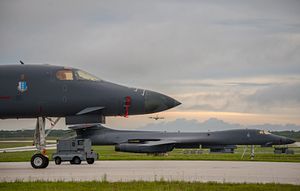Two U.S. B-1B strategic bombers conducted a nighttime training exercise with Japan Air Self Defense Force (JASDF) and Republic of Korea Air Force (ROKAF) military aircraft in the vicinity of the Sea of Japan on October 10, U.S. Pacific Command said in a statement.
“Using Andersen Air Force Base, Guam as a power projection platform, two B-1B Lancers assigned to the 37th Expeditionary Bomb Squadron, deployed from Ellsworth Air Force Base, South Dakota, conducted the first combined nighttime training mission between U.S. Pacific Command B-1B Lancers and Japanese and South Korean fighters,” the statement reads.
Yonhap news agency reports that the drill included two ROKAF F-15K Slam Eagles. On the Japanese side, two F-15J Eagles fighter jet were involved. Both types of fighter jets have participated in training missions with the U.S. B1-Bs in the past.
According to the press release, the sequential nighttime drill aimed to improve combined capabilities and tactical skills, while also building confidence and strong working relationships.
“Flying and training at night with our allies in a safe, effective manner is an important capability shared between the U.S., Japan and [South] Korea, and hones the tactical prowess of each nations’ aviators,” said U.S. Air Force Major Patrick Applegate, from the 613th Air Operation Center. “This is a clear demonstration of our ability to conduct seamless operations with all of our allies anytime, anywhere.”
The B-1Bs flying from Guam entered the Korean Air Defense Identification Zone Tuesday evening, where they simulated air-to-ground missile firing drill with two F-15K fighters over the East Sea, flew across the Korean Peninsula, followed by another firing exercise over the Yellow Sea.
The U.S. Air Force’s B-1B fleet is no longer nuclear-capable following conversion to a conventional-only delivery platform beginning in 2007. The B-1B, however, remains a formidable weapons platform.
“The USAF’s 62 B-1B Lancers are capable of carrying up to 75,000 pounds (34,000 kilograms) of weapons — the largest payload of both guided and unguided weapons in the USAF’s inventory. Though heavily armed, the bomber can reach a top speed of Mach 1.2 and can operate at altitudes above 30,000 feet (9,100 meters),” I explained elsewhere.
Last month, USAF B-1B bombers flew north of the 38th parallel near the coastline of the Korean Peninsula. According to a U.S. Pacific Command spokesperson, it was the furthest north “any U.S. fighter or bomber aircraft have flown off North Korea’s coast in the 21st century.”
North Korea has threatened to shoot down B1-Bs “even when they’re not yet inside the airspace border of our country,” North Korean Foreign Minister Ri Yong-ho said in September.

































